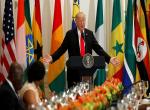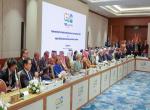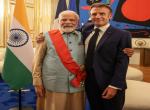The menace which has been created by the Sunni militant group, Islamic State (IS) is likely to stay for some time to come. Despite the United States (US)-led coalition airstrikes to destroy the terror organisation , there has been no significant decline in its activities. Rather, it is spreading to different parts of the globe and other terror groups are pledging allegiance to it.
Amid the coalition airstrikes, there are visible developments which have clearly indicated that the IS would continue to sustain for some time to come. Beginning with the rumours about the death or injury of IS leader Abu Bakr al-Baghdadi and his subsequent audiotape message disproving the story, there were other events which suggested that this militant group still possessed the vigour to expand its influence globally. This article highlights some of the recent developments, in West Asia, Northern Africa and in the Af-Pak region, which have signalled that its early days to write off the Islamic State.
Islamic State in Iraq
Over the past couple of months, several developments had taken place on both the fronts, that is, the US-led airstrikes as well the continuing influence of the IS. While the airstrikes could, to some extent, keep a check on IS-related activities in Kobane (in Syria), the situation inside Iraq has not seen any remarkable improvement. The battle between the Iraqi forces and the IS militants continue to tear several cities and towns of the oil-rich country. The group continues to carry out dastardly attacks amid the US-led airstrikes, reflecting the unrelenting efforts of the outfit to make its presence felt. The IS also attracted a wider attention for its brutalities towards the Yazidis, particularly, towards the women of this minority community. Forced conversion to Islam and sexual enslavement are the most heinous crimes being committed against the Yazidis. Further, there are indications that the Islamic State is not giving up its fight against the coalition forces, and it continues to march further towards the goal of expanding its influence far and wide.
Recent Developments in West Asia and Northern Africa
A significant development was the recent unconfirmed news about either the death or the injury of the self-proclaimed caliph, Abu Bakr al-Baghdadi, following a coalition attack against a convoy in Mosul (in Iraq) in early November.
Once the unconfirmed news were flashed, several views came to the fore about the fate of the radical Islamist leader, and most importantly, speculations pertaining to the influence or strength of the organisation without a charismatic leader like Abu Bakr al-Baghdadi. A question that cropped up was whether the IS could maintain the Caliphate in the absence of Al-Baghdadi. The reactions of the people from the region and elsewhere were rather mixed. Nevertheless, some of the most common assumptions hovered around the possibility that the strength of the IS could wane and it would lose its vigour to fight. Simultaneously, there were others who felt that the outfit would turn more hostile and this carried high possibilities of more bloodshed in the region.1 It was also speculated that Al-Baghdadi’s followers and admirers could become more aggressive with his death. This assumption is made mainly out of the significant influence he could leave in different parts of the world. In the immediate region, there were fears of more sectarian killings inside Syria and Iraq.
After staying out of the public domain for days, the IS released an audiotape with a message that dispelled the rumours. The 17-minute clip that surfaced at the time when US President Barack Obama was holding discussions to send more troops to Iraq appeared to be aimed at “belittling”2 the efforts of the American leader to tackle the IS. Al-Baghdadi, in his message, urged his disciples to “erupt volcanoes of jihad everywhere.”3 This coincided with the announcement of loyalty to IS by the most dangerous Egyptian militant organisation, Ansar Beit al-Maqdis. Other smaller militant groups in Yemen, Algeria and Libya have reportedly expressed allegiance to IS. Al Baghdadi exhorted his fighters to rise up against the Saudi royal family and to inflict more violence on Shiite Muslims. He severely criticised Saudi’s role in the US-led coalition’s airstrikes against his militants. In his words, "O sons of al-Haramayn...the serpent's head and the stronghold of the disease are there...draw your swords and divorce life, because there should be no security for the Saloul.”4 In fact, he used a derogatory term while referring to Saudi Arabia.
For Israel, the allegiance sworn by groups likes Ansar Beit al-Maqdis is a matter of grave concern. This is in the light of the growing terrorist activities in the Sinai Peninsula since the overthrow of the Hosni Mubarak regime in February 2011. The escalated terrorism in the Sinai region has already caught considerable international attention. Recently, this Egypt-origin group blew up the pipeline that carried gas from Egypt to Jordan.5Furthermore, there have been reports of fighters from the Gaza Strip who joined the IS out of their own volition.
Israel has figured prominently as one of IS’s main targets, and it once said, “Islamic State will do everything within its means to continue striking down every apostate who stands as an obstacle on its path towards Palestine.”6 There is a growing popularity of the IS in few of the Arab dominated cities, namely, Nazareth and Akko, inside Israel. The gradual radicalisation of Israeli Arab youths has concerned the Israeli security establishment. Shin Bet, the Israel Security Agency, has estimated that about 30 Israeli Arabs are believed to have joined the IS.7 Although the number of those who reportedly joined the group is quite marginal, Israeli security agencies have their concerns. With the developments in and around the country, a close nexus between IS and the regional militant groups would give immense headache to Israeli government and its security apparatuses. Further penetration of the IS or its influence inside Israel or in its immediate neighbourhood would add more fuel to the already tensed up and volatile situation. As it is, targets against Israelis and Jewish establishments inside the country and abroad are on the rise, and there are possibilities that either IS or other extremist groups would carry out further attacks.
There are other indications that the IS would continue to wield its influence. One of them is the reported reunification of the Al-Qaeda affiliated Jabhat al-Nusra and the IS in November 2014. Both these groups were separated in February 2014 due to certain differences. However, with the US-led coalition airstrikes in Syria, rumours resurfaced about the efforts of these arch rivals to merge once again to fight the combined forces. According to available sources, a meeting involving representatives from the IS, Nusra Front and the Khorasan Group was held in Syria.8 Khorasan group, mainly composed of veterans from the Al-Qaeda in Afghanistan and Pakistan, has attracted a wider attention. Any merger of these groups would have serious ramifications for the US-led forces in their fight against these militant groups not only inside Syria or Iraq but in other places as well. They are heavily-armed organisations, with indomitable zeal to fight the Western forces in their respective regions. IS alone has a considerable number of fighters pegged at several thousands. While an earlier CIA estimation stood at 20,000 to 31,500 fighters, a senior Kurdish leader recently said that the “number of militant fighters is at least 200,000”, or “seven or eight”9 times bigger than the former’s estimation. Although the given number could be an exaggerated one, it is a clear reflection of the far-reaching influence the IS has while recruiting young cadres.
Equally worrisome factor is the development in the Northern African region where one could see a rising IS presence. The rise of radical Islam in Libya, particularly after the death of its leader, Colonel Muammar Gaddafi is one of the most profound threats faced by the country. Presently, Libya is witnessing a low-level insurgency in cities such as Benghazi which is fanned by radical Islamist ideology promoted by those groups which have refused to identify with the concept of modern state and its institutions. Former dictator Muammar Gaddafi had carried out a brutal crackdown on the “expression of Islamism”10 by using security forces. The city was marginalised during Gaddafi’s reign and that gave birth to discontentment amongst the citizens, especially the youth. Since his death, the Libyan government has not been able to provide necessary military, political and financial support needed to resolve the crisis in a few Islamist strongholds, including Derna. Terror groups such as Ansar al-Sharia (AS) have grown military and politically, and have decided to support the IS. This, in itself, is a dreaded combination.
Derna is the latest addition to al-Baghdadi’s self-proclaimed Caliphate, and it has become the first city to join the Caliphate outside Iraq and Syria. This city has a population of about 100,000. In late October 2014, around 800 fighters pledged their allegiance to IS. In the recent past, about 300 Libyan jihadists fought for the IS in Deir Ezzor (in Syria) and Mosul (in Iraq), and they are believed to have returned to the country to support pro-IS factions such as the Shura Council for the Youth of Islam in Derna.11 This is an equally alarming development for Egypt as well.
IS’s announcement of the takeover of Derna has come at a juncture when the country is struggling in its fight against the growing influence of extremist groups. Further, the incursion of the IS into Libya is an indication of its ability to exploit local conditions in areas where the potential for its expansion exists. And, this has a tremendous potential to spill-over towards the European countries which have already seen many of their radicalised citizens fighting for the IS in West Asia. This is significant keeping in view the geographical location of Derna, which is situated along the coast of Mediterranean Sea.
IS in the Af-Pak Region
Pakistan:
Although there are no confirmed reports of IS officially establishing its presence, there are evidences of progression of its influence in Pakistan. This has come at a juncture when there is a visible resurgence of terrorist attacks, with the impending drawdown of the US troops from the neighbouring Afghanistan. Moreover, the growing radicalisation of its society would go in the favour of the Islamic State. Pakistan would be a ‘big-catch’ if this group succeeds in capturing, even a few, Pakistani military establishments as they did in Iraq and Syria, whereby they seized a considerable volume of weapons systems. The military-security agencies in Pakistan would have to take up measures to prevent its nuclear arsenals from falling into the hands of any terrorist groups. IS, however, is likely to face certain hurdles in its endeavours to enter the country. As noted strategist Sushant Sareen eloquently puts it:
One big disadvantage that the IS will suffer in its quest to make Pakistan a province or its Caliphate is that, for now, at least, it doesn’t enjoy the support of the Pakistani Army which continues to back Mullah Omar, the other pretender to the title of Amir—ul-Momeen. On the flip side, the IS has advantages that the Taliban or their patrons in the GHQ Rawalpindi don’t.12
Pakistan’s connection with the IS began in July 2014, when Tehreek-e-Khilafat announced its allegiance to Abu Bakr al-Baghdadi.13 This group is considered to be the first outfit outside West Asia to have pledged allegiance to the IS. From this, it is evident that the Sunni militant organisation, with local support, is influencing the radicalised minds in Pakistan, and this is a dangerous trend. IS reportedly recruited approximately “10,000 to 12,000 followers from the Hangu district of Khyber Pakhtunkhwa and Kurram tribal district”14 but there are no official reports so far to prove the veracity of this claim.
In Pakistan, an intense campaigning for the IS is on through distribution of pamphlets, display of posters and flags in different town and cities, including Lahore. In one such instance, the Pakistani security establishment raised an alarm as they found flags near the historic city of Taxila (near Islamabad), which is very close to the Pakistan Ordnance Factory (POF). This had happened after a small delegation of the IS reportedly visited Jundullah, a banned terror organisation located in southwestern Balochistan province, in November. That the IS flag was found inside the country is indicative of the long term vision of the group to establish a state based on Islamic laws across the world, and most importantly, it reflects the sympathy for IS within Pakistan. Further, a graffiti written in Urdu says, "We welcome the head of Syrian Daish Group Abu Bakkar Al Bagdadi and pay him tributes.” IS reportedly sent out propaganda booklets in parts of the Af-Pak tribal belt and in some Afghan refugee camps situated in Peshawar, but they were seized by security agencies. The rising number of sympathisers inside the country could facilitate the growth of IS influence in the region. The discontented and radicalised youths of Pakistan are susceptible to the recruitment process of the IS.
The IS had started to make inroads into Pakistan and Afghanistan in September 2014 when Abdul Raheem Muslim Dost, who was a former Guantanamo prison detainee was made the chief of Khorasan for the Afghan, Pakistani, Iranian and Central Asian belt.15 He is believed to be the man behind the recruitment of jihadists for the IS, and the graffiti campaign is considered to be his handiwork. Thereafter, other Pakistan-based militant groups such as Lashkar-e-Jhangvi (LeJ) and Ahl-e-Sunnat Wal Jamat (ASWJ)16 were believed to have offered their assistance to the IS but have not confirmed their allegiance to IS.
What triggered the support to the IS? It is partially the sectarian appeal of the IS that has enticed militant organisations from the region. These are Sunni militant groups which exhibit hatred for the Shia community, which is a minority in Pakistan. Six leading figures from the Tehreek-e-Taliban Pakistan (TPP) pledged allegiance to the IS’s charismatic leader. It is because of the sectarian nature inside Pakistan that many of the officials considered the displays of posters and flags as an intimidation towards the Shiites. As attacks against Pakistani government establishments by such amalgamated groups cannot be ruled out, the chief of the Muttahida Qaumi Movement (MQM), Altaf Hussain, termed IS as a more dangerous militant group than Taliban and Al- Qaeda, and called for immediate steps to tackle this rising threat inside the country. However, Chaudhry Nisar Ali Khan, the Federal Interior Minister, negated the claims of IS presence inside Pakistan.17 Interestingly, this statement from the minister surfaced just a couple of days after the government of Balochistan sent a report to the concerned Pakistani authorities about a “master plan” of the IS.18 From these conflicting views, it becomes apparent, as Sareen aptly pointed out, the Pakistani officials are “nonchalant about the IS’s presence in Pakistan…”
The growing influence of the IS in Pakistan is well-timed, particularly, with the impending drawdown of the US troops from Afghanistan. It is evident that the IS envisages further actions against Pakistan and Afghanistan. If the IS succeeds in gaining a foothold inside this country, it will pose a major threat not only to Pakistan but the entire region.
Afghanistan:
While IS-related activities inside Afghanistan are not as visible as they are inside Pakistan, there have already been predictions about the potential inroads that this group could make into this country. With the US troops nearing to its withdrawal, there is a mounting concern about the resurgence of terrorism inside Afghanistan and this is evidenced by the increasing terror activities.
Along the course of its endeavours, the IS might find strong supporters inside Afghanistan. For instance, Ahrarul Islam which is a faction of the Tehreek-e-Taliban is believed to be operating on the lines of the IS with similar objectives, and this group negates the sanctity of boundaries between states.19 As a result, they are trying to establish a strong network throughout the regions covering South and Central Asia. However, they have not sworn allegiance to the IS or recognised the Caliphate established by Abu Bakr al-Baghdadi and they still consider Taliban’s chief Mullah Mohammed Omar as the chief. This is similar to the approach of East Turkistan Islamic Movement (ETIM) or Hizb-e-Islami Turkistan. Meanwhile, militant group such as Hezb-e-Islami have expressed their willingness to join al-Baghdadi if the latter manages to form a “true Islamic caliphate.”20 Its leader, Mirwais, released this statement during the recently-concluded presidential election in Afghanistan. This has signified the gradually rising importance of the IS. And, Afghanistan appears to be an enticing destination for the IS given its staunch anti-Shia posture. It is yet to be seen how successfully the IS would influence the Afghan terror groups to join hands with it.
In Afghanistan, one cannot ignore the dimension of a potential power tussle between the already-existing groups and the IS. Al-Qaeda and Taliban would not want to see the latter taking up a leading role in fighting the government and the foreign troops. This is where the question of relevance crops up. Looking at the recent developments, none of the older terror outfits could attract the kind of attention as much as the Islamic State is doing. Its speedy rise to a larger global phenomenon even astonished various terror organisations. Due to this, Al-Qaeda operatives in different countries and the Taliban, particularly in Afghanistan, feel the need to revive their status as the most dreaded groups. Al-Baghdadi’s desire to have a larger role in the region was exhibited by a letter allegedly written by him to Al-Qaeda’s chief, Ayman al-Zawahiri. In the letter, he advised al-Zawahiri to “swear allegiance to him in return for a subordinate position in his makeshift state”, and he also called the Taliban’s “commander of the faithful” “an ignorant, illiterate warlord, unworthy of spiritual or political respect.”21 Al-Zawahiri, however, continues to remain committed to the one-eyed Taliban chief. This has exposed the differences that exist between IS and the aforementioned groups. Therefore, even if these groups do not merge with IS, there are possibilities that other jihadist groups originating in the region would do so. Simultaneously, there is an ever widening divide, inside Afghanistan, between those who support Taliban and those who are welcoming the IS.
Al-Zawahiri’s announcement for the establishment of the Al-Qaeda in the Indian Subcontinent (AQIS) has been considered as an attempt to project his group’s relevance in the region, especially when the IS has grabbed significant attention in India, Pakistan, and other South East Asian countries. The security apparatuses in the region do not take the announcement as an immediate threat but, at the same time, it is not taken casually. This outfit might strike back violently to restore its prestige, and a fierce competition with the IS might usher in.
Lastly, one cannot afford to ignore the support IS continues to receive from different extremist groups in different parts of the world. Another worrisome factor is the involvement of foreign jihadists while carrying heinous crimes such as beheadings. Such inhumane acts signify the depth of indoctrination of the foreign recruits by the IS. Considering the large number of foreign fighters in the IS camps, this is a serious trend that is developing. It is not only the European jihadists (apart from West Asian-origin) that are fighting in Syria and Iraq, but quite a few from Southeast Asian countries such as Malaysia (between 30 and 40), Indonesia (more than 50), Philippines and Singapore have reportedly travelled to the conflict-torn region.22 This has starkly exposed the sympathy for the IS in this part of Asia. Tellingly, factors such as sectarian divide; affiliation with radical ideologies promoted by IS; humanitarian assistance for the fellow Muslim citizens in Iraq and Syria; social and political discontentment have been attributed for the movement of radicalised youths from these mentioned countries. In most of the cases, such departure of people has been facilitated with the help of robust online recruitment process using social media, and with the involvement of a few local citizens.
Conclusion:
The growing influence of the IS gives an impression that it is still early to predict its downfall. While the US-led air strikes could defeat the IS physically, the deeply entrenched radical ideology propagated by this militant group, particularly while luring extremist outfits, appears to be far more dangerous to contain. As a result, those countries which are affected either directly or indirectly by this outfit cannot afford to remain unconcerned with the developments in their regions.
While it is the need of the hour for the international community to build a strong network of cooperation to tackle the IS menace collectively, it is also imperative to take up stringent measures within the respective countries to prevent the rise of radical Islamist forces and various forms of recruitment processes. It is often seen that IS penetrates into a country where there is a serious political turmoil and sectarian crisis. Given such a scenario, authorities concerned have a huge task of engaging constantly with communities which are more prone to getting succumbed to the extreme ideology of the IS. Beyond militaristic approach, one should also conduct in depth sociological analyses to find out as to why the IS has been successful in brainwashing the youngsters to join the outfit, or exhibit sympathy. It should be clear that the Islamic State is unlikely to be tackled anytime soon. Beyond its physical presence or destruction it could inflict on a state, it has become a matter of ideology, which would be far difficult to fight. Therefore, its influence or any of its activities in different parts of the world should not be downplayed.
Endnotes
- For a relevant reading, see Theodore Karasik, “Can ISIS maintain the ‘Caliphate’ without Baghdadi”, Al Arabiya, 9 November 2014, http://english.alarabiya.net/en/views/news/middle-east/2014/11/09/Striking-the-ISIS-chief-the-implications-of-Baghdadi-s-alleged-death.html
- David D. Kirkpatrick and Rick Gladstone, “ISIS Chief Emerges, Urging ‘Volcanoes of Jihad”, The New York Times, 13 November 2014.
- Ibid.
- “Islamic State leader urges attacks in Saudi Arabia”, Reuters, 13 November 2014, http://www.reuters.com/article/2014/11/13/us-mideast-crisis-baghdadi-idUSKCN0IX1Y120141113
- Dalit Halevy, “ISIS Blows Up Egypt-Jordan Gas Pipeline”, Arutz Sheva, 15 November 2014, http://www.israelnationalnews.com/News/News.aspx/187471#.VHyjrTGUe0c. This is a 1,200-kilometre long pipeline built at a cost of US$1.2 billion meant for exporting natural gas to countries such as Jordan, Syria and Lebanon.
- Lev Selmon, “Islamic State vows to reach ‘Palestine’ and ‘Kill the barbaric Jews”, The Jerusalem Post, 30 August 2014, http://www.jpost.com/Arab-Israeli-Conflict/Islamic-State-vows-to-reach-Palestine-and-kill-the-barbaric-Jews-372796
- Yossi Melman, “The Phenomenon of Israeli Arabs joining Islamic State”, The Jerusalem Post, 20 October 2014. http://www.jpost.com/Israel-News/Analysis-The-phenomenon-of-Israeli-Arabs-joining-Islamic-State-379268
- Deb Riechmann, “IS, al-Qaida reach accord in Syria”, Associated Press, 13 November 2014, http://bigstory.ap.org/article/c71e3be959414e69bde25f792e18aad6/ap-sources-al-qaida-reach-accord-syria
- “War with Isis: Islamic militants have army of 200,000, claims Kurdish leader”, The Independent, 16 November 2014, http://www.independent.co.uk/news/world/middle-east/war-with-isis-islamic-militants-have-army-of-200000-claims-kurdish-leader-9863418.html
- “Libya has become the latest Isil conquest”, The Telegraph, 24 October 2014, http://www.telegraph.co.uk/news/worldnews/africaandindianocean/libya/11186153/Libya-has-become-the-latest-Isil-conquest.html
- Paul Cruickshank, Nic Robertson, et al., “ISIS comes to Libya”, CNN, 18 November 2014, http://www.cnn.com/2014/11/18/world/isis-libya/
- Sushant Sareen, “Islamic State: Prospects in Pakistan”, Articles, No. 4740, 17 November 2014, Institute of Peace and Conflict Studies, http://www.ipcs.org/article/pakistan/islamic-state-prospects-in-pakistan-4740.html
- For a relevant report, see Rob Crilly, “Pakistani terror group swears allegiance to Islamic State”, The Telegraph, 9 July 2014, http://www.telegraph.co.uk/news/worldnews/asia/pakistan/10955563/Pakistani-terror-group-swears-allegiance-to-Islamic-State.html
- “ISIS spreading tentacles in Pakistan: Report”, The Times of India, 9 November 2014, http://timesofindia.indiatimes.com/world/pakistan/ISIS-spreading-tentacles-in-Pakistan-Report/articleshow/45085103.cms
- Further information is available at, Thomas Joscelyn, “Gitmo ‘Poet’ Now Recruiting for Islamic State”, The Weekly Standard, 19 November 2014, http://www.weeklystandard.com/blogs/gitmo-poet-now-recruiting-islamic-state_819587.html
- “ISIS spreading tentacles in Pakistan: Report”, The Times of India.
- “Nisar rubbishes ISIS presence”, The Nation, 12 November 2014, http://nation.com.pk/karachi/12-Nov-2014/nisar-rubbishes-isis-presence
- Mujeeb Ahmed, “ISIS Has Master Plan for Pakistan, Secret Memo Warns”, NBC News, 10 November 2014, http://www.nbcnews.com/storyline/isis-terror/isis-has-master-plan-pakistan-secret-memo-warns-n244961
- Shamim Shahid, “Spillover effect: ISIS making inroads into Pakistan, Afghanistan”, The Express Tribune, 3 September 2014, http://tribune.com.pk/story/757186/spillover-effect-isis-making-inroads-into-pakistan-afghanistan/
- John Simpson, “Afghan militant fighters ‘may join Islamic State”, BBC News, 2 September 2014, http://www.bbc.com/news/world-asia-29009125
- Sami Yousafzai and Sam Seibet, “ISIS vs. the Taliban: The Battle for Hearts and Mind”, Vocativ, 5 November 2014, http://www.vocativ.com/world/afghanistan-world/isis-vs-taliban/?page=all
- For a relevant reading, see Joseph Chinyong Liow, “ISIS Goes to Asia”, Foreign Affairs, 19 September 2014, http://www.foreignaffairs.com/articles/142004/joseph-chinyong-liow/isis-goes-to-asia
Published Date: 16th December 2014










Post new comment